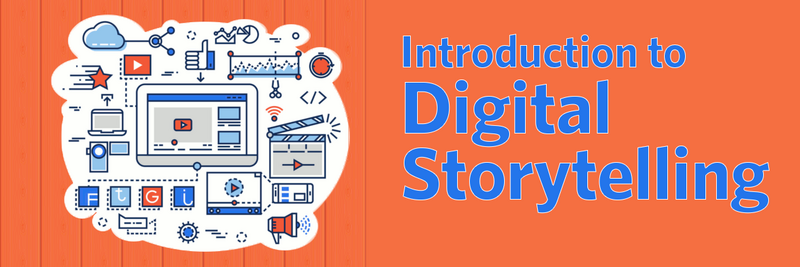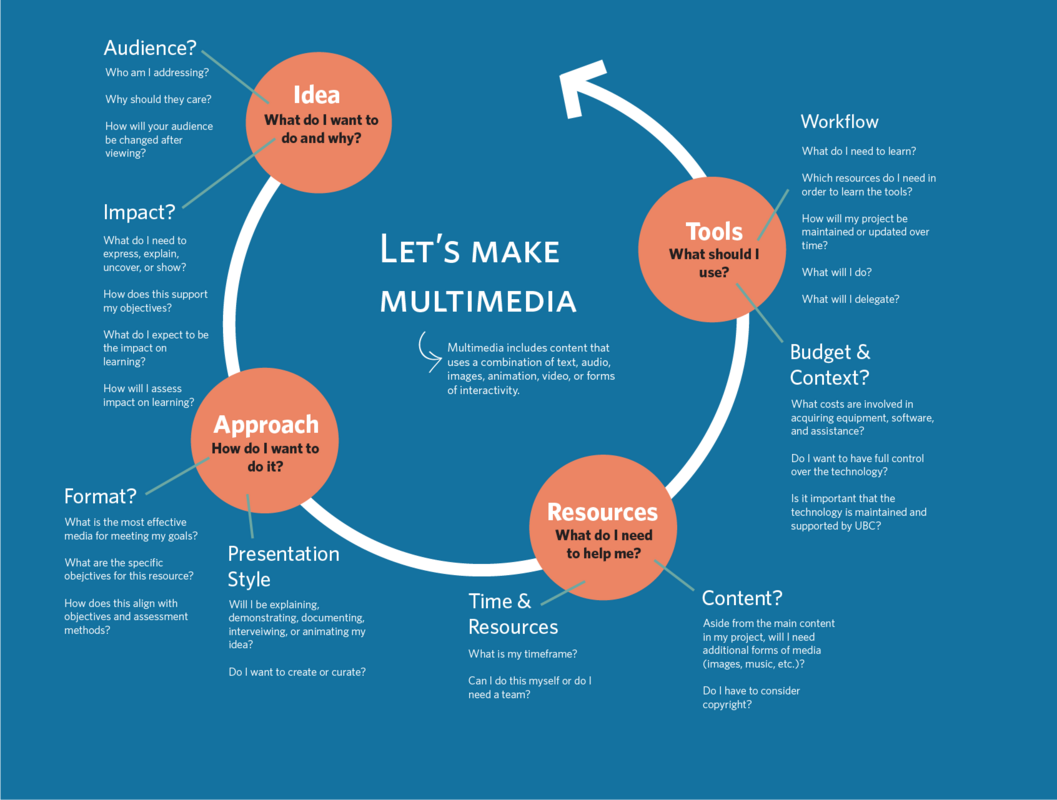LFS:Workshops/Digital Storytelling

Original graphic by Shaylin Lee, CC 4.0
Prompt:
If you had to create a digital story to explain why you chose to come to UBC,
what form would it take? What would it sound and look like? What tools would you use?
What is a digital story?
At its most basic, a digital story can be any story you tell using digital tools.
It is synonymous with first person narrative stories accompanied by a slideshow,
but it can extend much further beyond that, encompassing any and all digital tools.
- StoryCenter
- Digital Stories Canada
- Faculty of Education's Scarfe Sandbox
So, why tell a story?
Narrative stories help people connect to information in different ways. It can appeal to their emotions, it can help them identify with the story, and it can make it more memorable. Science communication is no different. Telling people stories about science can help them understand it more clearly and recognize its impact on their lives.
UBC TerreWeb video, as mentioned in the NY Times.
Plan it!
UBC's DIY Media guide
Digital Tools
Photos
- The Basics
- Always check the resolution, especially if you'll have movement. The frame for a video is 1920 x 1080
Audio
- Audio and Podcasting
- Audacity audio editor
Video
Equipment
- Smartphones
- LFS Learning Centre
- UBC resources
Getting the best shot
- Stabilizing the camera
- Tripods
- Binder clips
- The 'rule of thirds'
- Lighting
- Using sunlight
- Three-point lighting
- Thinking of your background
- Smartphone specific tips
- Make sure to have enough memory and that phone is charged
- If necessary, delete older photos, videos, apps
- Go into Airplane Mode (preserves battery and prevents interferences on the audio)
- Shoot horizontally not vertical (think of cinema and your eyes)
What to capture
- Multiple angles
- Room for edits (wait a beat or count to 10)
- B-roll
Editing
- Camtasia allows for basic editing
- Free download for UBC community
- iMovie & MovieMaker
- Adobe Premiere Pro is available for more sophisticated projects (also free for UBC users)
- On campus facilities (Learning Centre Media Lab is also available)
Formats
Video Formats
- Screencasts with Camtasia (available in Canvas)
- Recorded lectures
- Whiteboard videos & Videoscribe
- Whiteboard thesis
- Video essay
Non-Video Formats
- Podcasts
- Timelines
- Dynamic websites
- And beyond...UBC's Emerging Media Lab
Copyright
Copyright basics
- UBC Copyright office
- Your copyrighted works
- Other people’s copyrights
- Fair dealing / fair use
Creative Commons
- The licenses
- Allow commercial uses?
- Allow modifications? Yes, Yes but, No
- Attribution is always required
- Licenses are irrevocable
- Does not account for privacy issues
Creative Commons resources
- Learning Centre wiki page
- Photos: Pixabay / Unsplash
- Music: Free Music Archive
- Video, etc.: The Internet Archive / Wikimedia Commons / Pexels
Sharing
- UBC's Kaltura
- integrated with Canvas
- you should not be posting videos directly to Canvas. Much better to use Kaltura or, if it's appropriate, another platform.
- YouTube: public / unlisted / private
Creating a story
Dramatic Structure
A story is...
- is someone doing something for a reason
- builds tension
- has stakes
- has a beginning middle and an end
- has a hook
One simple way to test whether your story is worth telling on the radio is to tell it to your friends, and notice how you feel. Do you feel like you’re dragging through one tedious moment after another, always on the verge of losing their interest, and sometimes you’re not even sure what the story’s about or why you’re telling certain parts? Or are your friends laughing and buying you drinks and begging you for more details about the characters? When you’re done, does everyone at the table launch into an excited discussion of similar things that happened to them? Heed these signs. If you can’t tell the story compellingly to a friend, it means either you haven’t figured out what the story is really about, or much more likely it never will be possible to tell this story compellingly over the radio.
(Also notice, incidentally, the way you tell your friends the story: where you begin it, what background facts you feel compelled to throw in and where you throw them in, what parts of the story you tell in what order, what parts of the story you leave out, what parts of the story seem weaker when you tell them. The way you tell the story to your friends is often the best structure for the story on the radio. Sometimes, when someone’s stuck on writing a story for our show, I or one of the other producers will have them put down their notes and logs and just tell us the story, to hear the structure they naturally use in telling it aloud.)
And yes, there are ways to get a story to work. Often this means you have to think about what the heart of the story is about, and figure out how to make that more present. This can involve adding moments and scenes that build up the central conflict (and pruning away the ones that don’t). It can mean making explicit what the story means, stating more directly what the point of the whole thing is. More about that below.
— Ira Glass, Transom “What’s A Story?”
